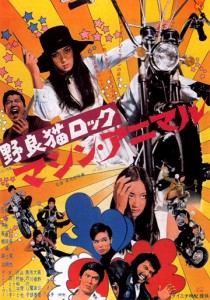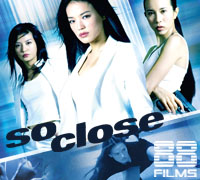AKA: Alleycat Rock: Machine Animal
Director: Yasuharu Hasebe
Writer: Ryuzo Nakanishi
Producer: Masami Kuzu
Cast: Meiko Kaji, Tatsuya Fuji, Bunjaku Han, Jiro Okazaki, Toshiya Yamano, Eiji Go, Yasuhiro Kameyama
By Kyle Warner
The Stray Cat Rock series continues with the fourth entry, Machine Animal. Like the films that came before it, Machine Animal was a quick production, filmed over just two weeks and released a little over two months after the previous entry. Machine Animal is also the third film in the series directed by Yasuharu Hasebe, and the fourth Stray Cat Rock film to be released in 1970. Up until this point, the fast shoots hadn’t hurt the quality of the films, but with Machine Animal I got the impression that the rushed schedule was beginning to take its toll. Machine Animal is the least original of the series, taking ideas and moments from the earlier films and reutilizing them to tell a new story. It’s still an entertaining film, but it lacks the same energy found in the first three entries.
In the film, two “redneck” drifters (Tatsuya Fuji and Jiro Okazaki) and their friend Charlie, a Vietnam War deserter, are trying to get out of Japan. They plan to sell 500 tabs of acid in order to pay for a boat ride to Sweden, but they don’t know anyone in town that’ll buy the drugs. Eventually they befriend a delinquent girl gang led by Maya (Meiko Kaji) and she tries to help them out. Maya goes to the motorcycle gang the Dragons and sets up a deal. However, the leader of the Dragons (Eiji Go, younger brother to action star Jo Shishido) is a greedy man – why buy the drugs when you can steal them? Things get violent, multiple people are kidnapped, and we rush towards a tragic conclusion that is typical for the Stray Cat Rock series.
Machine Animal feels a bit like a blend of Hasebe’s first two Stray Cat Rock films, complete with a motorcycle chase that’s very similar to the one from Delinquent Girl Boss and the returning theme of Americans in Japan during the 70s as previously seen in Sex Hunter.
The new ingredient that Machine Animal brings to the series is the illegal drugs. Instead of talking about Japan’s drug culture of the time, the acid is mostly used as a prop to keep the plot moving. Hasebe’s first two Stray Cat Rock films have their trippy moments thanks to his wild style and some interesting editing techniques. In Machine Animal, the acid gives Hasebe an excuse to go all-out with an explosion of style, but he mostly limits the weird stuff to one drug sequence. When the guys and girls drop some acid, they giggle like mad while the screen inexplicably splashes blood into frame. It’s an interesting sequence because it shows the characters having fun but the audience is momentarily lost in a horror movie. During this acid trip, Meiko Kaji and Tatsuya Fuji choose not to indulge and instead observe with a displeased expression before exiting the room. I expected Hasebe to use the sequence to provide some laughs and crazy visuals but instead he used the opportunity to say something unexpected. The characters on acid are laughing like everything’s a joke. But the joke, Hasebe seems to say, is actually on them.
Despite the film’s dark subject matter, Machine Animal often has a lighter tone for much of its brief runtime. When a friend gets kidnapped and driven away, Meiko Kaji shouts, “Sh*t! We need Hondas!” Cut to Kaji and co. going to a Honda dealership, taking a few motorcycles for a test drive, and chasing after the bad guys. It’s goofy but it’s also my favorite part of the movie. Other bits of comedy also work, but the film’s drama isn’t often as successful – the action sequences lack tension, kidnappings seem to accompany every plot twist, and some of the performances are kind of flat.
The film’s lead actors Meiko Kaji, Tatsuya Fuji, Jiro Okazaki, and Eiji Go all give good performances. Kaji’s character is somewhat similar in all of Hasebe’s Stray Cat Rock films, but Tatsuya Fuji and Jiro Okazaki get to stretch their acting muscles a bit by playing some country boys lost in the big city. Eiji Go (Retaliation) is creepy as the villain and screenwriter Ryuzo Nakanishi (Massacre Gun) provides the villain with some unexpected depth, giving him as much reason to seek revenge in the finale as any of the protagonists. On the flip side of the coin, most the girls in Maya’s gang are rather weak (and sometimes annoying) and Toshiya Yamano is bad as Charlie – which is a shame, because Charlie’s a very important character to the film.
I found Machine Animal to be the most frustrating film of the series because it has all the right parts (even if some of them are clearly borrowed from earlier entries) but for some reason it refuses to fully come to life. Still, while I consider Machine Animal to be my least favorite of Yasuharu Hasebe’s Stray Cat Rock films, I don’t think it’s a bad movie, and I’d definitely recommend it to curious viewers who are fans of Japanese cinema.
Kyle Warner’s Rating: 6.5/10




